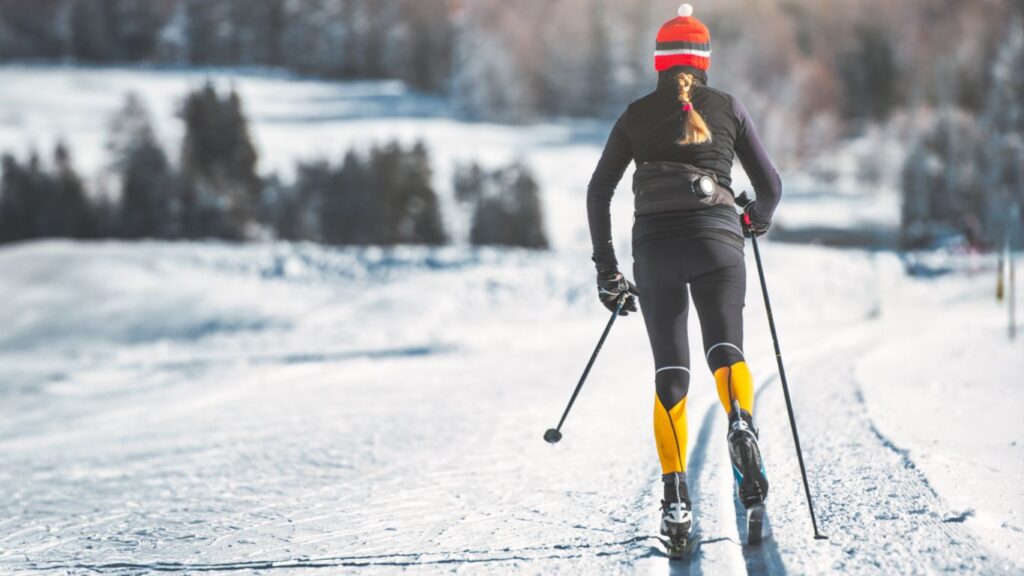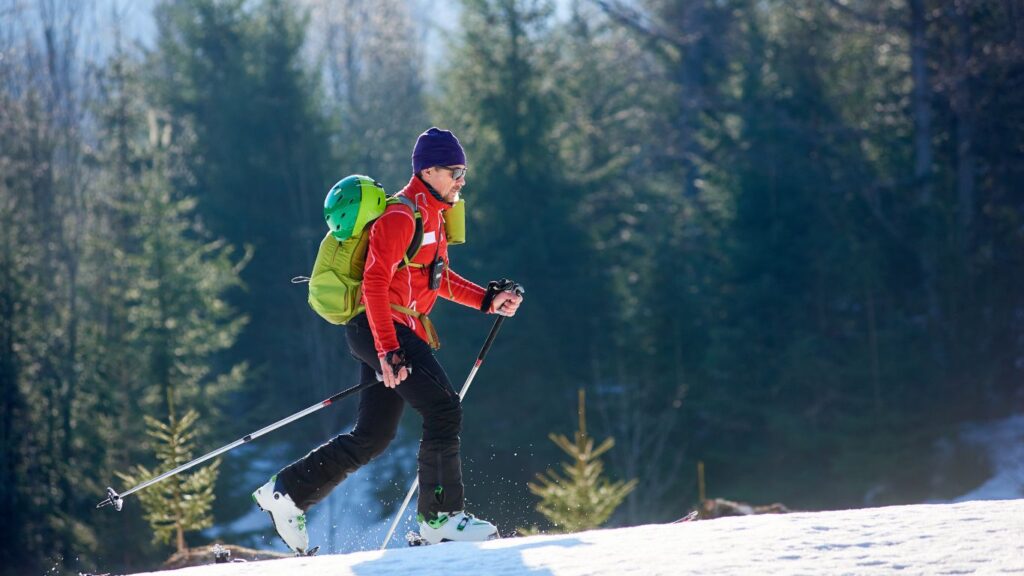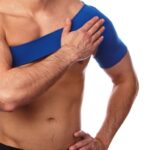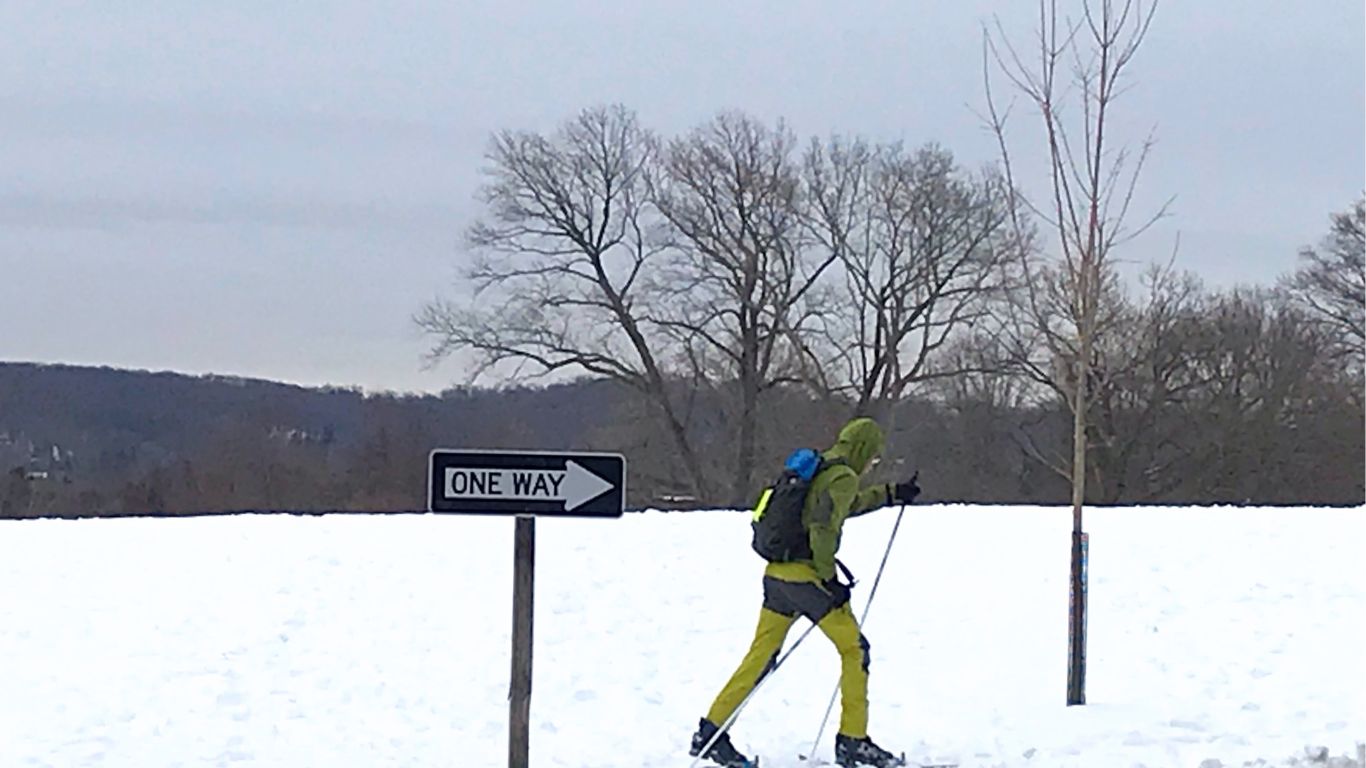Introduction: The Importance of Cross-Country Skiing Attire
Cross-country skiing is a rewarding and exhilarating winter activity that requires proper clothing to ensure comfort, safety, and performance. Dressing appropriately for the varying temperatures you’ll encounter is crucial. It protects you from the elements and enhances your overall skiing experience by allowing you to move freely and maintain your body temperature effectively.
This guide will help you choose the proper attire for cross-country skiing in two specific temperature ranges: 20°F to 40°F and 0°F to 20°F. We’ll cover the essentials of layering, selecting suitable base layers, insulating layers, outerwear, and accessories to keep you warm and dry.
Layering for Cold Temperatures

Layering is the key to staying comfortable while cross-country skiing. You can easily adjust your clothing to match temperature changes and activity levels by dressing in layers. The three main layers are:
- Base Layer: Wicks moisture away from your skin.
- Insulating Layer: Provides warmth.
- Outer Layer: Protects against wind and water.
Choosing the Right Base Layer
Your base layer is the foundation of your skiing attire. It should fit snugly and contain moisture-wicking materials to keep you dry and warm.
20°F to 40°F:
- Base: Moisture-wicking long-sleeve shirt and pants.
0°F to 20°F:
- Base: Thermal top and bottom for maximum warmth and moisture-wicking properties.
Insulating Layer Options
The insulating layer traps body heat to keep you warm. The type and thickness of this layer can vary based on the temperature and your preference.
20°F to 40°F:
- Insulation: Fleece or soft-shell jacket and pants for warmth without bulk.
0°F to 20°F:
- Mid: Insulated vest or fleece jacket for extra warmth.
Windproof and Waterproof Outerwear Selection
The outer layer should shield you from wind, snow, and rain while allowing moisture to escape.
20°F to 40°F:
- Outer: Wind-breaking, water-resistant shell jacket and pants to protect against weather.
0°F to 20°F:
- Outer: Insulated, waterproof jacket and pants to protect against cold and wet conditions.
Accessories for Extra Warmth and Protection
Accessories are vital in keeping extremities warm and protected from the elements.
20°F to 40°F:
- Hat and Gloves: Insulated, waterproof gloves and a warm hat to protect extremities.
- Wool Socks: Thick, warm wool socks to keep feet dry and warm.
0°F to 20°F:
- Balaclava or Face Mask: To protect against extreme cold and wind.
- Gloves and Mittens: Insulated, waterproof gloves and mittens for the hands.
- Double-layered, high-quality socks: For additional warmth.
Additional Tips for Cross-Country Skiing Attire

- Dress in Layers: Easily adjust for temperature changes and activity levels.
- Moisture-Wicking Fabrics: Choose fabrics that wick moisture away from your skin to prevent chills.
- Eye Protection: Wear sunglasses or goggles to protect your eyes from snow glare and UV rays.
- Sunscreen: Even in winter, protect your skin from sunburn and windburn.
- Extra Gear: Bring an extra set of gloves and socks in case they get wet.
- Boot Fit: Ensure your boots fit well and provide good ankle support for comfort and control.
- Ski-Specific Socks: Consider using ski-specific socks to help prevent blisters.
Outfit Summary
20°F to 40°F:
- Base: Moisture-wicking long-sleeve shirt and pants.
- Insulation: Fleece or soft-shell jacket and pants.
- Outer: Wind-breaking, water-resistant shell jacket and pants.
- Accessories: Insulated, waterproof gloves, warm hat, and wool socks.
0°F to 20°F:
- Base: Thermal top and bottom.
- Mid: Insulated vest or fleece jacket.
- Outer: Insulated, waterproof coat and pants.
- Accessories: Balaclava or face mask, insulated, waterproof gloves and mittens, double-layered socks.
FAQs
What should I do if I start to overheat while cross-country skiing?
If you start overheating, you must adjust your layers to manage your body temperature efficiently. Start by unzipping your jacket or removing a hat. If you feel too warm, consider shedding a layer, such as your insulating layer, and store it in your backpack or tie it around your waist. Remember to adjust your layers gradually to avoid getting too cold.
How can I stay dry while cross-country skiing?
Opt for moisture-wicking base layers that pull sweat away from your skin to stay dry. Your outer layer should be windproof and waterproof, ensuring you stay dry from external moisture, such as snow or rain. Also, ensure your gear fits well and is tight enough, as tight gear hinders breathability and moisture management.
What are the best materials for cross-country skiing clothing?
The best materials for cross-country skiing clothing include synthetic fabrics like polyester or nylon for the base layer, as they wick moisture away from your skin. Materials like fleece or down are excellent options for insulation, as they provide warmth without bulk. Finally, for the outer layer, look for windproof and waterproof materials, such as Gore-Tex, to protect you from the elements.
How do I keep my extremities warm in frigid temperatures?
Invest in high-quality gloves or mittens that are insulated and waterproof to keep your extremities warm. Consider wearing a hat that covers your ears, and in freezing weather, use a balaclava or face mask for added protection. Thick, wool socks or double-layered socks are essential for keeping your feet warm, and ensure your boots are well-fitted for added insulation.
Is wearing a face mask or balaclava necessary while cross-country skiing?
Wearing a face mask or balaclava is not always necessary, but it is highly recommended in frigid temperatures (0°F to 20°F) to protect your face from windburn and frostbite. It also helps retain warmth and makes a notable difference in overall comfort, especially on windy days.
Can I wear my regular winter coat for cross-country skiing?
A regular winter coat might not be the best option for cross-country skiing, as these coats are often too bulky and not designed for high-intensity activities. It’s crucial to have a jacket that’s both breathable and provides adequate insulation without restricting your movements. Opt for a coat specifically designed for winter sports.
How do I prevent blisters on my feet while cross-country skiing?
To prevent blisters:
- Wear moisture-wicking, ski-specific socks that fit well and are designed to reduce friction.
- Make sure your boots fit correctly without being too tight or too loose.
- If blisters are recurring, consider using blister pads or applying anti-blister balms before you head out.
What type of eyewear is best for cross-country skiing?
The best eyewear for cross-country skiing includes sunglasses or goggles with UV protection to shield your eyes from the sun’s glare reflecting off the snow. Goggles are handy in snowy or windy conditions to prevent snow from getting into your eyes. Look for eyewear that fits comfortably with your headgear and has anti-fog features.
Conclusion: Dressing Appropriately Enhances Cross-Country Experience
By dressing in appropriate layers and selecting the right clothing items for different temperature ranges, you can ensure a comfortable and enjoyable cross-country skiing experience. Remember, the key to staying warm and dry is proper layering, moisture-wicking fabrics, and protective outerwear. With the right attire, you’ll be able to fully embrace the beauty and challenge of cross-country skiing, no matter the weather.










